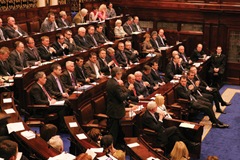All change?
 Irish Times political correspondent Harry McGee asks whether the changes in the Dáil are a temporary consequence of the public anger towards Fianna Fáil, or a permanent phenomenon.
Irish Times political correspondent Harry McGee asks whether the changes in the Dáil are a temporary consequence of the public anger towards Fianna Fáil, or a permanent phenomenon.
The 31st Dáil is a statistician’s dream. The general election has produced perhaps the greatest sea-change in the chamber since Fianna Fáil triumphed in the general election of 1932.
Almost half of the TDs in the Dáil were not in the last Dáil. Some 76 deputies are new with a further six returning, having previously lost their seats. And the massive change of course is Fianna Fáil. The party had never really dipped below 70 seats and its core support was always regarded as in the mid-thirties, percentage-wise.
Its dramatic collapse is without precedent in the history of the state. The party, which was never bested by another single party in almost 30 elections, plummets to a distant third, its support falling to 17 per cent; its seat tally a paltry 20. It is without a single female deputy and with a solitary TD – Brian Lenihan – in Dublin.
Other parties have broken their own records in filling the Fianna Fáil vacuum. The Labour Party almost doubled its representation, winning 37 seats, while Sinn Féin also more than doubled its returns with 14 TDs in the new Dáil, including party leader Gerry Adams. With 14 TDs, independents have returned to their 2002 level, while the United Left Alliance reflects the resurgence of a harder left politics in Ireland.
The alliance’s five elected TDs give it comparable status to the Workers Party and Democratic Left in the 1980s and 1990s.
Strangely, the only party that has not broken all records is the party perceived to be the big winner; Fine Gael. It won 76 seats, which is a record. But it came on the back of 36 per cent support which was a not all that amazing result. The party actually surpassed that in 1982 when it won 39 per cent support. But then it won only 70 seats on that higher level of support and still played second fiddle to Fianna Fáil which won 76 seats.
There have been several claims made in relation to this election result that are not borne out by the evidence. Certainly, it was historic. But there is not all that much to support the contention that it finally represents the major realignment of Irish politics – away from civil war lines to the more conventional left-right divide.
Sure, left-wing parties have made some gains.
But those gains must be seen in the context of the over-riding reality of this election campaign. It was about Fianna Fáil; and more specifically, voters punishing Fianna Fáil for the profligacy that was fostered and encouraged during 14 years of uninterrupted power. As the Fine Gael TD Brian Hayes so succinctly put it: “We are all feasting on the carcass of Fianna Fáil.”
When you analyse the voting pattern, two tropes are self-evident. The vast majority of citizens believed that there was no alternative but to pursue the austerity measures being implemented by the outgoing Government. And secondly, they wanted anybody but the outgoing Government to do the necessary.
It’s not difficult to see why. Voting in Fianna Fáil would be like a stabbing victim waking up in hospital to find out the surgeon doing the life-saving operation on him with a scalpel is the same guy who knifed him on the street earlier.
And so, in voting for a Fine Gael and Labour coalition, voters have opted for limited change – change of personnel rather than a change of direction. It’s not surprising that the new Government will pursue the same policies and programme of the old Government for the next two years.
In reality, there is never any dramatic shift with government change in Ireland. It is a small and settled democracy with well- established systems of administration, politics and law. It is true that the political system has become ineffective and over-clientilist in recent times. But those who argue for political reform as the panacea for all our problems are misguided. What has gone wrong in Irish politics hasn’t been the system; it has been the very poor quality of decision-making; the lack of imagination; as well as the lack of courage to stand up to vested interests on behalf of the citizen.
The new Dáil will be fascinating. Fine Gael and Labour have a huge majority which will give security but will create some problems further down the line. Some of the more ambitious new TDs will eventually get tired of being spear carriers and may cause ripples of discontent. Fine Gael has got off to a flying start with Enda Kenny having a faultless first ten days – first of all facing down Angela Merkel and Nicholas Sarkozy over corporation tax and then having a hugely successful visit to the White House, topped by President Obama’s announcement he will visit Ireland. For Labour, it’s been a little more faltering – Eamon Gilmore’s choices for Cabinet found him being back-footed over claims of sexism. Gilmore’s choices for Cabinet all fall into the experienced, slightly conservative and safe pair of hands category.
Gerry Adams will make an impact on the Dáil. The party has a couple of very smart new TDs and they also give an impetus that was lacking in the group of four that was in the 30th Dáil. However, are the big strides made by Sinn Féin redolent of longer term growth or just another symptom of the Fianna Fáil collapse? And the same could be asked of the independents. Is there a cohesive block for the future or is it a temporary arrangement?
All that depends on Fianna Fáil. The party has been devastated and will take two Dáil terms to make a major return. Even then, will it be able to return as strongly as before? The party has little going for it at the moment. There are too many uninspiring deputies among its 20; too many of the old guard are poised to return to the Seanad; Sinn Féin is also breathing down its neck. Fianna Fáil will occupy a strange space, literally and metaphorically, in the new Dáil.

